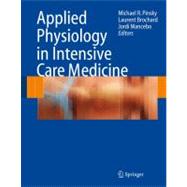
| Physiological Notes | |
| Pulmonary | |
| Respiratory Mechanics | |
| Intrinsic (or auto-) positive end-expiratory pressure during controlled mechanical ventilation | p. 3 |
| Intrinsic (or auto-) positive end-expiratory pressure during spontaneous or assisted ventilation | p. 7 |
| Work of breathing | p. 11 |
| Interpretation of airway pressure waveformsEvans R. Fernandez-Perez | p. 15 |
| Gas exchange | |
| Dead space | p. 17 |
| Alveolar ventilation and pulmonary blood flow: The V[subscript A]/Q[subscript T] concept | p. 21 |
| Mechanisms of hypoxemia | p. 25 |
| Pulse oximetry | p. 29 |
| Effects of body temperature on blood gases | p. 33 |
| Venous oximetry | p. 37 |
| Influence of F[subscript l]O[subscript 2] on the P[subscript a]O[subscript 2]/F[subscript l]O[subscript 2] ratio | p. 41 |
| Cardiovascular | |
| Pulmonary vascular resistance: A meaningless variable? | p. 45 |
| Pulmonary artery occlusion pressure | p. 49 |
| Clinical significance of pulmonary artery occlusion pressure | p. 53 |
| Pulmonary capillary pressure | p. 57 |
| Ventricular interdependence: how does it impact on hemodynamic evaluation in clinical practice? | p. 61 |
| Cyclic changes in arterial pressure during mechanical ventilation | p. 65 |
| Metabolism and Renal Function | |
| Lactic acidosis | p. 69 |
| Defining renal failure: Physiological principles | p. 73 |
| Hypotension during intermittent hemodialysis: new insights into an old problem | p. 79 |
| Cerebral Function | |
| Intracranial pressure: Part one: Historical overview and basic concepts | p. 85 |
| Intracranial pressure: Part two: Clinical applications and technology | p. 89 |
| Physiological Reviews | |
| Measurement techniques | |
| Fluid responsiveness in mechanically ventilated patients: a review of indices used in intensive care | p. 95 |
| Different techniques to measure intra-abdominal pressure (IAP): time for a critical re-appraisal | p. 105 |
| Tissue capnometry: does the answer lie under the tongue? | p. 121 |
| Noninvasive monitoring of peripheral perfusion | p. 131 |
| Ultrasonographic examination of the venae cavae | p. 143 |
| Physiological processes | |
| Sleep in the intensive care unit | p. 147 |
| Magnesium in critical illness: metabolism, assessment, and treatment | p. 157 |
| Pulmonary endothelium in acute lung Injury: from basic science to the critically ill | p. 171 |
| Pulmonary and cardiac sequelae of subarachnoid haemorrhage: time for active management? | p. 185 |
| Permissive hypercapnia-role in protective lung ventilatory strategies | p. 197 |
| Right ventricular function and positive pressure ventilation in clinical practice: from hemodynamic subsets to respirator settings | p. 207 |
| Acute right ventricular failure - from pathophysiology to new treatments | p. 217 |
| Red blood cell rheology in sepsis | p. 229 |
| Stress-hyperglycemia, insulin and immunomodulation in sepsis | p. 239 |
| Hypothalamic-pituitary dysfunction in critically ill patients with traumatic and nontraumatic brain injury | p. 249 |
| Matching total body oxygen consumption and delivery: a crucial objective? | p. 259 |
| Normalizing physiological variables in acute illness: five reasons for caution | p. 269 |
| Seminal Studies in Intensive Care | |
| Manipulating afterload for the treatment of acute heart failure: a historical summary | p. 279 |
| Nosocomial pneumonia | p. 283 |
| The introduction of positive end-expiratory pressure into mechanical ventilation: a retrospective | p. 291 |
| Elastic pressure-volume curves in acute lung injury and acute respiratory distress syndrome | p. 295 |
| The concept of "baby lung" | p. 303 |
| The effects of anesthesia and muscle paralysis on the respiratory system | p. 313 |
| Diaphragmatic fatigue during sepsis and septic shock | p. 323 |
| The use of severity scores in the intensive care | p. 331 |
| Oxygen transport-the oxygen delivery controversy | p. 337 |
| Organ dysfunction during sepsis | p. 345 |
| Ventilator-induced lung injury: from the bench to the bedside | p. 357 |
| Remembrance of Weaning Past: the Seminal Studies | p. 367 |
| Subject Index | p. 377 |
| Table of Contents provided by Ingram. All Rights Reserved. |
The New copy of this book will include any supplemental materials advertised. Please check the title of the book to determine if it should include any access cards, study guides, lab manuals, CDs, etc.
The Used, Rental and eBook copies of this book are not guaranteed to include any supplemental materials. Typically, only the book itself is included. This is true even if the title states it includes any access cards, study guides, lab manuals, CDs, etc.